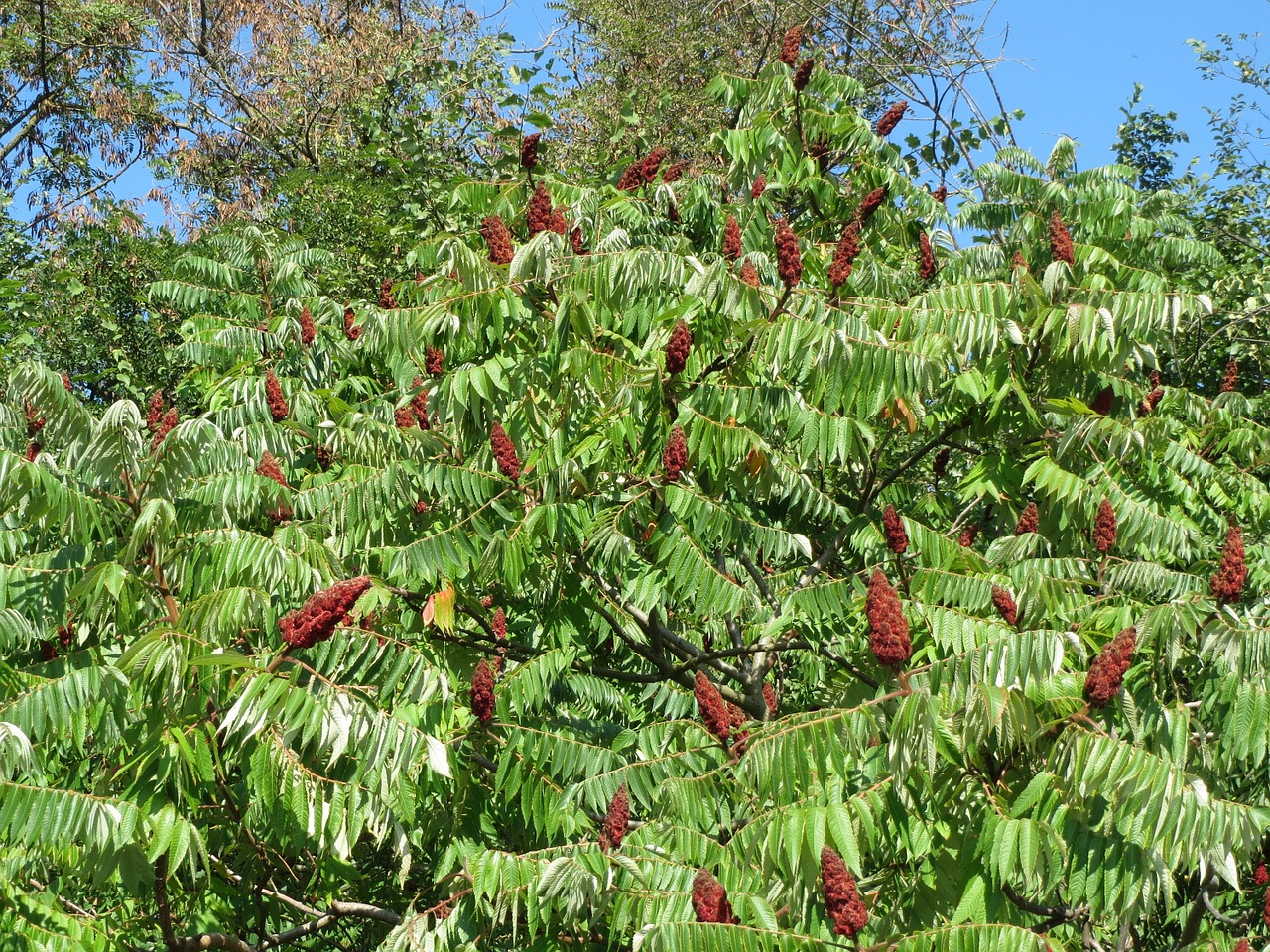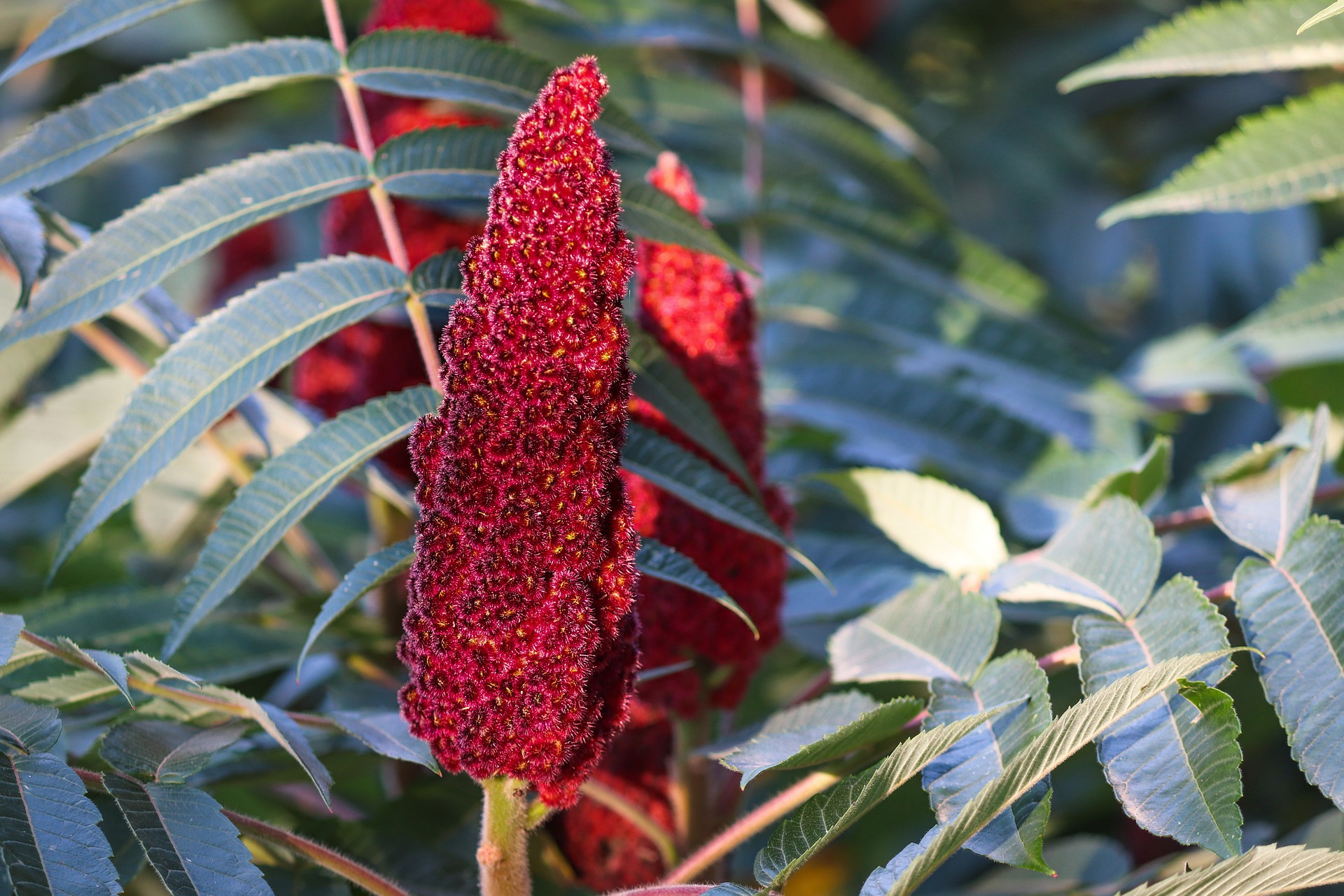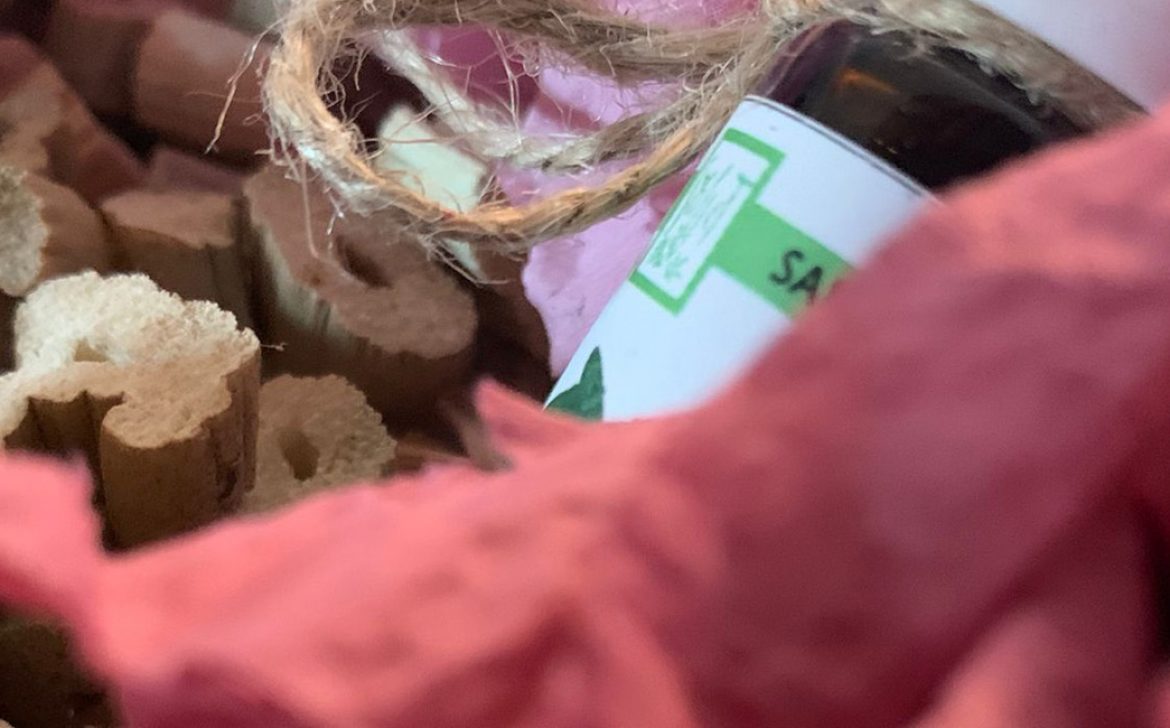Rhus coriaria L. (Sommacco siciliano): studio della composizione dell’olio essenziale e dei volatili di piante raccolte in Sicilia
Il testo che segue è solo un estratto di uno studio di tesi scientifico condotto sulla Rhus coriaria L. Per poter consultare il documento completo, compila il form che trovi in fondo alla pagina con i dati richiesti. Riceverai il PDF via email.
Introduzione
Rhus coriaria è una pianta conosciuta e diffusa soprattutto nei paesi medio-orientali ed in Africa, dove viene estesamente coltivata per la produzione dei frutti, che sono utilizzati in cucina, nella medicina popolare e come colorante per la concia delle pelli.
In cucina il frutto macinato è usato per conferire un caratteristico sapore acidulo alle carni; nella medicina popolare si ricorda l’impiego per problemi intestinali, per l’attività antibatterica ed antiossidante.
In Italia è presente in Liguria, lungo la penisola ed in Sicilia, dove è da considerarsi una pianta rara, residuo di antiche coltivazioni, che si sono andate estinguendo poco a poco.
Lo scopo della presente tesi è stato quello di:
- analizzare la composizione dell’olio essenziale e dei composti volatili (SPME) dei frutti della pianta, raccolta in tre diverse località della Sicilia, dove cresce spontanea;
- confrontare tale composizione con quella della specie diffusa nelle aree medio-orientali e con la letteratura scientifica a riguardo;
- ripristinare la coltivazione e l’uso popolare che si è perso nel tempo;
- valorizzare l’impiego dei frutti essiccati come spezia, analogamente a quanto accade per il mercato medio-orientale.



Conclusioni
Dalle analisi gascromatografiche effettuate sia sugli olii essenziali che sulle frazioni volatili di tre diversi campioni di frutti di Rhus coriaria, raccolti in Sicilia, si evidenzia come siano presenti differenze di composizione, relative soprattutto alla diversa percentuale di alcuni dei costituenti principali. Differenze che potrebbero essere riconducibili alla variabilità genetica e/o ambientale tipica di piante che si sono sviluppate spontaneamente nell’habitat dove sono state raccolte e che non hanno subìto alcuna selezione agronomica.
Nella sperimentazione futura potrebbe essere utile effettuare una selezione del materiale di partenza ed una coltivazione agronomica per consentire di ottenere una coltura più omogenea, riferibile in particolare ad una composizione più vicina a quella del Sommacco coltivato in medio-oriente e presente sul mercato alimentare come spezia.
Infatti il materiale da noi analizzato si discosta parecchio nella composizione dei volatili dal campione commerciale di frutti di Rhus coriaria, proveniente dal mercato giordano e ciò si manifesta con un diverso aroma e quindi sapore. Tuttavia conferma l’uso di sommacco siciliano come aromatizzante dei cibi, così come avviene nelle popolazioni medio orientali, e mette in risalto gli sforzi relativi alla sua valorizzazione anche in Italia sia nella cucina che in medicina. Ecco che tale confronto può essere l’inizio di un percorso di valorizzazione del Rhus coriaria.
- Adwan, G., Abu-Shanab, B., Adwan, K., Abu-Shanab, F., 2006. Antibacterial effects of nutraceutical plants growing in Palestine on Pseudomonas aeruginosa. Turkish Journal of Biology 30, 239-242.
- Adwan, G.M., Abu-shanab, B.A., Adwan, K.M., 2009. In vitro activity of certain drugs in combination with plant extracts against Staphylococcus aureus infections. Afr. J. Biotechnol. 8, 4239-4241.
- Adwan, G., Abu-Shanab, B., Adwan, K., 2010. Antibacterial activities of some plant extracts alone and in combination with different antimicrobials against multidrugresistant Pseudomonas aeruginosa strains. Asian Pacific Journal of Tropical Medicine 3, 266-266.
- Aliakbarlu, J., Mohammadi, S., Khalili, S., 2013. A Study on antioxidant potency and antibacterial activity of water extracts of some spices widely consumed in iranian diet. Journal of Food Biochemistry.
- Anwer, T., Sharma, M., Khan, G., Iqbal, M., Ali, M.S., Alam, M.S., Safhi, M.M., Gupta, N., 2013. Rhus coriaria ameliorates insulin resistance in non-insulin-dependent diabetes mellitus (NIDDM) rats. Acta poloniae pharmaceutica 70, 861-867.
- Bahar, B., Altug, T., 2009. Flavour Characterization of Sumach (Rhus Coriaria L.) by Means of GC/MS and Sensory Flavour Profile Analysis Techniques. International Journal of Food Properties 12, 379-387.
- Beretta, G., Rossoni, G., Santagati, N.A., Facino, R.M., 2009. Anti-ischemic activity and endothelium-dependent vasorelaxant effect of hydrolysable tannins from the leaves of Rhus coriaria (Sumac) in isolated rabbit heart and thoracic aorta. Planta medica 75, 1482-1488.
- Bursal, E., Koeksal, E., 2011. Evaluation of reducing power and radical scavenging activities of water and ethanol extracts from sumac (Rhus coriaria L.). Food Res. Int. 44, 2217-2221.
- Cakilcioglu, U., Turkoglu, I., 2010. An ethnobotanical survey of medicinal plants in Sivrice (Elazi{dotless}ĝ-Turkey). Journal of ethnopharmacology 132, 165-175.
- Capcarova, M., Slamecka, J., Abbas, K., Kolesarova, A., Kalafova, A., Valent, M., Filipejova, T.,
- Chrastinova, L., Ondruska, L., Massanyi, P., 2012. Effects of dietary inclusion of Rhus coriaria on internal milieu of rabbits. Journal of animal physiology and animal nutrition 96, 459-465.
- Chakraborty, A., Ferk, F., Simić, T., Brantner, A., Dušinská, M., Kundi, M., Hoelzl, C., Nersesyan, A., Knasmüller, S., 2009. DNA-protective effects of sumach (Rhus coriaria L.), a common spice: Results of human and animal studies. Mutation Research – Fundamental and Molecular Mechanisms of Mutagenesis 661, 10-17.
- Chen, G.Z., Chen, H.Z., 2011. Extraction and deglycosylation of flavonoids from sumac fruits using steam explosion. Food Chemistry 126, 1934-1938.
- Erturk, O., 2010. Antibacterial and Antifungal Effects of Alcoholic Extracts of 41 Medicinal Plants growing in Turkey. Czech Journal of Food Sciences 28, 53-60.
- Ertürk, Ö., Uslu, U., 2007. Antifeedant, growth and toxic effects of some plant extracts on Leptinotarsa decemlineata (Say.) (Coleoptera, Chrysomelidae). Fresenius Environmental Bulletin 16, 601-607.
- Etxeberria, U., De La Garza, A.L., Campin, J., Martnez, J.A., Milagro, F.I., 2012. Antidiabetic effects of natural plant extracts via inhibition of carbohydrate hydrolysis enzymes with emphasis on pancreatic alpha amylase. Expert Opinion on Therapeutic Targets 16, 269-297.
- Fazeli, M.R., Amin, G., Attari, M.M.A., Ashtiani, H., Jamalifar, H., Samadi, N., 2007. Antimicrobial activities of Iranian sumac and avishan-e shirazi. (Zataria multiflora) against some food-borne bacteria. Food Control 18, 646-649.
- Gharaei, A., Khajeh, M., Ghaffari, M., Choopani, A., 2013. Iranian Rhus coriaria (sumac) Essential Oils Extraction. Journal of Essential Oil Bearing Plants 16, 270-273.
- Golzadeh, M., Farhoomand, P., Daneshyar, M., 2012. Dietary Rhus coriaria L. powder reduces the blood cholesterol, VLDL-c and glucose, but increases abdominal fat in broilers. South African Journal of Animal Science 42, 398-405.
- Gunduz, G.T., Gonul, S.A., Karapinar, M., 2010. Efficacy of sumac and oregano in the inactivation of Salmonella Typhimurium on tomatoes. International journal of food microbiology 141, 39-44.
- Hartwell, J.L., 1982. Plants Used Against Cancer: A Survey. Quarterman Pub.,
Incorporated, Lawrence. - Iauk, L., Caccamo, F., Speciale, A.M., Tempera, G., Ragusa, S., Pante, G., 1998.
Antimicrobial activity of Rhus coriaria L. leaf extract. Phytother. Res. 12, S152-S153. - Idolo, M., Motti, R., Mazzoleni, S., 2010. Ethnobotanical and phytomedicinal knowledge in a long-history protected area, the Abruzzo, Lazio and Molise National Park (Italian Apennines). Journal of ethnopharmacology 127, 379-395.
- Kurucu, S., Koyuncu, M., Guvenc, A., Baser, K.H.C., Ozek, T., 1993. The essential oils of Rhus coriaria L. (Sumac). J. Essent. Oil Res. 5, 481-486.
- Kossah, R., Nsabimana, C., Zhang, H., Chen, W., 2010. Optimization of extraction of polyphenols from syrian sumac (Rhus coriaria L.) and Chinese sumac (Rhus typhina L.) fruits. Res. J. Phytochem. 4, 146-153.
- Kossah, R., Nsabimana, C., Zhao, J., Chen, H., Tian, F., Zhang, H., Chen, W., 2009. Comparative study on the chemical composition of Syrian sumac (Rhus coriaria L.) and Chinese sumac (Rhus typhina L.) fruits. Pak. J. Nutr. 8, 1570-1574.
- Kurucu, S., Koyuncu, M., Guvenc, A., Baser, K.H.C., Ozek, T., 1993. The essential oils of Rhus coriaria L. (Sumac). J. Essent. Oil Res. 5, 481-486.
- Lev, E., Amar, Z., 2002. Ethnopharmacological survey of traditional drugs sold in the Kingdom of Jordan. Journal of ethnopharmacology 82, 131-145.
- Madihi, Y., Merrikhi, A., Baradaran, A., Rafieian-Kopaei, M., Shahinfard, N., Ansari, R., Shirzad, H., Mesripour, A., 2013. Impact of Sumac on postprandial high-fat oxidative stress. Pakistan Journal of Medical Sciences 29, 340-345.
- Mamatkulova, N.M., Melikuziev, F.A., Mukarramov, N.I., Nishanbaev, S.Z., Khidyrova, N.K., Shakhidoyatov, K.M., 2012. Polyisoprenoids from Rhus coriaria. Chem. Nat. Compd. 48, 661-662.
- Mansour, F., Azaizeh, H., Saad, B., Tadmor, Y., Abo-Moch, F., Said, O., 2004. The Potential of Middle Eastern Flora as a Source of New Safe Bio-Acaricides to Control Tetranychus cinnabarinus, the Carmine Spider Mite. Phytoparasitica 32, 66-72.
- Mavlyanov, S.M., Islambekov, S.Y., Karimdzhanov, A.K., Ismailov, A.I., 1997. Anthocyans and organic acids of the fruits of some species of sumac. Chem. Nat. Compd. (Transl. of Khim. Prir. Soedin.) 33, 209.
- Mohammadi, S., Kouhsari Montasser, S., Feshani Monavar, A., 2010. Antidiabetic
properties of the ethanolic extract of Rhus coriaria fruits in rats. DARU, Journal of
Pharmaceutical Sciences 18, 270-275. - Morelli, I., Flamini, G., Pistelli, L., 2005. Manuale dell’erborista. Biosintesi, estrazione e identificazione delle sostanze di origine vegetale. Tecniche Nuove, Milano.
- Nasar-Abbas, S.M., Halkman, A.K., 2004. Antimicrobial effect of water extract of sumac (Rhus coriaria L.) on the growth of some food borne bacteria including pathogens. International journal of food microbiology 97, 63-69.
- Nasar-Abbas, S.M., Halkman, A.K., Al-Haq, M.I., 2004. Inhibition of some foodborne bacteria by alcohol extract of sumac (Rhus coriaria L.). Journal of Food Safety 24, 257-267.
- Neeman, G., Lahav, H., Izhaki, I., 1992. SPATIAL PATTERN OF SEEDLINGS 1 YEAR AFTER FIRE IN A MEDITERRANEAN PINE FOREST. Oecologia 91, 365-370.
- Nimri, L.F., Meqdam, M.M., Alkofahi, A., 1999. Antibacterial activity of Jordanian
medicinal plants. Pharmaceutical Biology 37, 196-201. - Ozcan, M., 2003a. Antioxidant activities of rosemary, sage, and sumac extracts and their combinations on stability of natural peanut oil. Journal of medicinal food 6, 267-270.
- Ozcan, M., 2003b. Effect of sumach (Rhus coriaria L.) extracts on the oxidative stability of peanut oil. Journal of medicinal food 6, 63-66.
- Ozcan, M., 2003. Mineral contents of some plants used as condiments in Turkey. Food Chem. 84, 437-440.
- Panico, A., Cardile, V., Santagati, N.A., Messina, R., 2009. Antioxidant and protective effects of Sumac leaves on chondrocytes. J. Med. Plants Res. 3, 855-861.
- Pignatti, S., Anzalone, B., 1982. Flora d’Italia. Edagricole, Bologna.
- Pizzi, A., Pasch, H., Rode, K., Giovando, S., 2009. Polymer structure of commercial hydrolyzable tannins by matrix-assisted laser desorption/ionization-time-of-flight mass spectrometry. J. Appl. Polym. Sci. 113, 3847-3859.
- Pourahmad, J., Eskandari, M.R., Shakibaei, R., Kamalinejad, M., 2010. A search for hepatoprotective activity of aqueous extract of Rhus coriaria L. against oxidative stress cytotoxicity. Food and chemical toxicology : an international journal published for the British Industrial Biological Research Association 48, 854-858.
- Pourrat, H., Regerat, F., Morvan, P., Pourrat, A., 1987. MICROBIOLOGICAL PRODUCTION OF GALLIC ACID FROM RHUS-CORIARIA L. Biotechnology Letters 9, 731-734.
- Quer, P.F., 1982. Plantas medicinales: el Dioscórides renovado. Con la descripción de 678 especies, acompañada de 752 figuras originales, 58 mapas y 33 láminas fuera de texto, 20 de ellas en color. Editorial Labor.
- Regazzoni, L., Arlandini, E., Garzon, D., Santagati, N.A., Beretta, G., Maffei Facino, R., 2013. A rapid profiling of gallotannins and flavonoids of the aqueous extract of Rhus coriaria L. by flow injection analysis with high-resolution mass spectrometry assisted with database searching. Journal of pharmaceutical and biomedical analysis 72, 202-207.
- Shahidi Bonjar, G.H., Nik, A.K., Heydari, M.R., Ghasemzadeh, M.H., Farrokhi, P.R., Moein, M.R., Mansouri, S., Foroumadi, A., 2003. Anti-pseudomona and anti-bacilli activity of some medicinal plants of Iran. Daru : journal of Faculty of Pharmacy, Tehran University of Medical Sciences 11, 157-163.
- Sharma, R., Arya, V., 2011. A review on fruits having anti-diabetic potential. Journal of Chemical and Pharmaceutical Research 3, 204-212
- Van Loo, P., De Bruyn, A., Verzele, M., 1988. On the liquid chromatography and
identification of the flavonoids, present in the “sumach tannic acid” extracted from Rhus coriaria. Chromatographia 25, 15-20. - Zalacain, A., Prodanov, M., Carmona, M., Alonso, G.L., 2003. Optimisation of extraction and identification of gallotannins from sumac leaves. Biosystems Engineering 84, 211-216.


